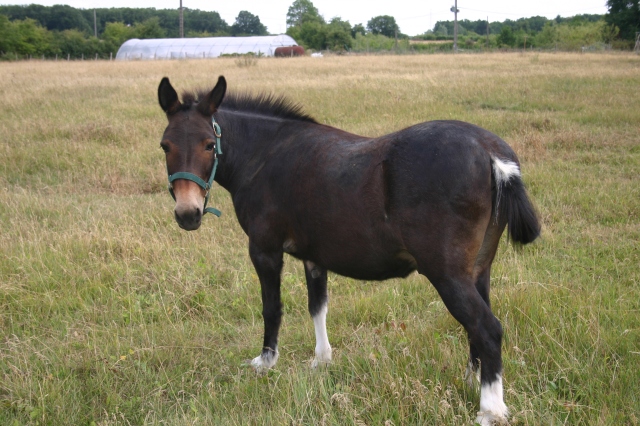Regular readers of the blog will know that my model for keeping donkeys was my friend Barbara’s pair of Jennies, Dalie and Rosie. Donkeys need companionship, so having two is a good plan. The problem is when you want to take one away walking for a while, the separation poses problems, particularly for the animal left behind. Barbara now has a solution in the form of Filou the mule (pictured above).
This new member of Barbara’s family had been standing around in a field for the last five years. ‘Apart from the state of his feet, horribly overgrown, he seems pretty fit,’ she tells me. ‘He is about seven or eight years old, and seems calm and happy. This may be because he is no longer enroute to the abattoir…. The deal was, find him a home or off he goes, the field is needed.’
I don’t know much about mules, apart from how they happen. A mule is the offspring of a male donkey and a mare. They were typically the main agricultural animals in this part of Spain, doing all the pulling work in the fields, while donkeys were mainly used for transport.
PS. While on the subject of equine breeding, the story of the revival of the quagga makes fascinating reading. http://www.quaggaproject.org/



I may want to amend the calm and happy bit. His encounter with the farrier was interesting, but didn’t result in neatly trimmed feet. We will try again tommorrow, in company with a vet and a large syringe of sedation. The vet has to come anyway to do his identification papers and vaccinate him. Fingers crossed!
Whoops! Sounds a bit like the encounter that my vet had with Rubi, for the routine vaccinations. She stood up on rear legs and kicked out dramatically.
The vet said, ‘Ahah, circus time!’ and I’m sure he added extra to the bill.
Is an ass half male horse and female donkey then? There seem to be a lot of them in Ireland. Are asses and mules deliberate or accidental?
No, you are describing a ‘hinny’. An ass is just another name for a donkey (equus asinus). Mules are deliberate in that they are (were) a useful animal, so bred for that purpose. They are accidental, in that nature produces some animal that are happy to mate more adventurously! Some male donkeys (Jacks) like to mount mares, but they are few and far between. Once a Jack gets a good reputation producing mules, he is highly sought after by breeders.
The wonders of modern medecine and a tolerant farrier have resulted in a mule with neatly trimmed feet. It will take a couple more sessions, but I am optimistic that he will be able to work, probably pulling the cart, but also with a pack saddle. Now we need to start going walkies. That will start this week, but not today as three days riding (horse, not donkey) and walking since friday leaves me needing to see to my garden, and generally sort out the house.
When you get an opportunity, send some photos of Dalie pulling the new cart and I’ll put them on the blog. There is a donkey webring and I was considering putting this blog on it, but it looks like the webring consists of dozens of ranches in the USA that specialise in miniatures! Can’t quite see the point of miniature donkeys (apart from the plastic one you gave me that now adorns my keyring!) So, I’ve had second thoughts about the donkey webring. I’m still working on the blog re-design, including an updated list of donkey web sites, but have been busy with fencing and other practical matters which have taken up the first days of the holiday! Have a good trip.